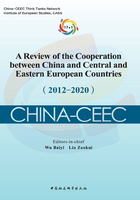
10. Deepening of Mutual Understanding with Robust People-to-people Exchanges
Since the inception of China-CEEC Cooperation, China-CEEC people-to-people exchanges have been developing at an unprecedented speed, with a rich variety of tourism, media, think tanks and youth events.
In terms of international tourism exchanges, the Year of Promotion of China-CEEC Tourism Cooperation was successfully organized in 2015. Since 2014, sessions of the China-CEEC High-level Conference on Tourism Cooperation have been held respectively in Hungary, Slovenia, Bosnia and Herzegovina, Latvia and Croatia. The China-CEEC Tourism Coordination Center, the China-CEEC Association of Tourism Promotion Agencies and Businesses and the China Tourist Office in Budapest were established successively in Hungary. CEECs have been invited to the China International Travel Mart on an annual basis. Chinese provinces and cities have organized a rich variety of events in CEECs. Thanks to a host of measures and incentives, the number of Chinese tourists visiting CEECs has grown rapidly, up by more than 5 times since 2012. Two-way travels exceed one million every year. In 2018, nearly one-third of the Chinese tourists visiting Europe visited CEECs. In light of this reality, Serbia, Montenegro, Bosnia and Herzegovina and Albania have granted visa-free or seasonal visa-free policies for Chinese passport holders. In 2016, China granted citizens of 16 CEECs (Greece not included) 72-hour visa-free transit.
Think tank exchanges have never been more active. Chinese and CEECs think tanks and academic institutes used to have close exchanges in history, but institutionalized, sizable and systematic exchanges had not happened before China-CEEC Cooperation was in place. An important symbol of institutionalized exchanges of China-CEEC think tanks was the official launch of the China-CEEC Think Tanks Network in December 2015, which is dedicated to fostering a high-level platform for coordination and exchanges among Chinese and CEEC think tanks. In 2019, the China-CEEC Global Partnership Center was established, to conduct research on the relevant policies and legislation and help think tanks and businesses establish links. Since then, a network of China-CEEC think tanks cooperation has been in place. In the meantime, vigorous efforts by the Chinese government to build a new type of think tanks have also resulted in more sizable, systematic, frequent, and effective think tank personnel exchanges.
China-CEEC youth exchanges have made positive progress. By the beginning of 2019, a number of programs had been initiated by the Confucius Institute Headquarters, such as the Summer Camp in China, the Chinese Bridge Chinese Language Proficiency Contest and the Confucius China Studies Program, which were well-received among CEEC youth and students. Since 2016, the Confucius Institute Headquarters has organized four sessions of Confucius Institute Summer Camp specially for CEECs, during which over 3,500 teachers and students visited China. So far, two sessions of China-CEEC Young Political Leaders’ Forum and three sessions of the Bridge of the Future youth exchange camps have been organized, which have significantly enriched and invigorated youth exchanges between China and CEECs.
[1] Calculated based on statistics published on the website of the Department of European Affairs of the Ministry of Commerce of China, http://ozs.mofcom.gov.cn/article/zojmgx/date/.
[2] http://www.icscc.org.cn/upload/file/20190225/20190225165752_21488.pdf.
[3] http://www.icscc.org.cn/upload/file/20190225/20190225165752_21488.pdf.
[4] Trade figures are based on statistics of the Chinese Customs, and investment figures are based on the database of the Chinese Ministry of Agriculture and Rural Affairs on external agricultural investment.
[5] In 1951, China and Poland established in Shanghai the Chinese-Polish Joint Stock Shipping Company, the first joint venture since the People’s Republic of China was founded. The Company is still operating well.
[6] During the visit of Vice President Zhu De to Czechoslovakia in early 1956, the Czechoslovakian government donated a set of 670 pieces of modern agricultural machinery for 100 thousand mu of arable land to China. In August of the same year, a donation ceremony took place in Cang County of Hebei Province, where it was decided that a state-owned farm would be built using the set of machinery. To mark the friendship between people of the two countries, as approved by the Chinese State Council, Premier Zhou Enlai named the farm China-Czechoslovakia Friendship Farm. The farm was designed to cover an area of 160 thousand mu and construction would be completed in 1957. Till today, the farm has been upgraded to an industrial zone, which is still playing an active role in promoting bilateral relations and helping Hebei Province better participate in China-CEEC Cooperation.
[7] Xu Gang,“Studies on Central and Eastern Europe in China since Reform and Opening-up: Preliminary Thinking Based on Disciplinary Construction”, Russian, East European and Central Asian Studies, No.1, 2020.
[8] Since China-CEEC Cooperation started, a number of research institutes have been established, including the Institute of Russian, Eastern European and Central Asian Studies of Renmin University, the Institute of Russian, Eastern European and Central Asian Studies of the Chinese Academy of Social Sciences (CASS), Department of Central and Eastern European Studies of the Institute of European Studies, CASS, and the Center of Central and Eastern European Studies of Beijing Foreign Studies University. The Department of Eastern European Studies of the CASS Institute of Russian, Eastern European and Central Asian Studies was eatablished before China-CEEC Cooperation was in place. Xu Gang,“Studies on Central and Eastern Europe in China since Reform and Opening-up: Preliminary Thinking Based on Disciplinary Construction”, Russian, East European and Central Asian Studies, No.1, 2020.